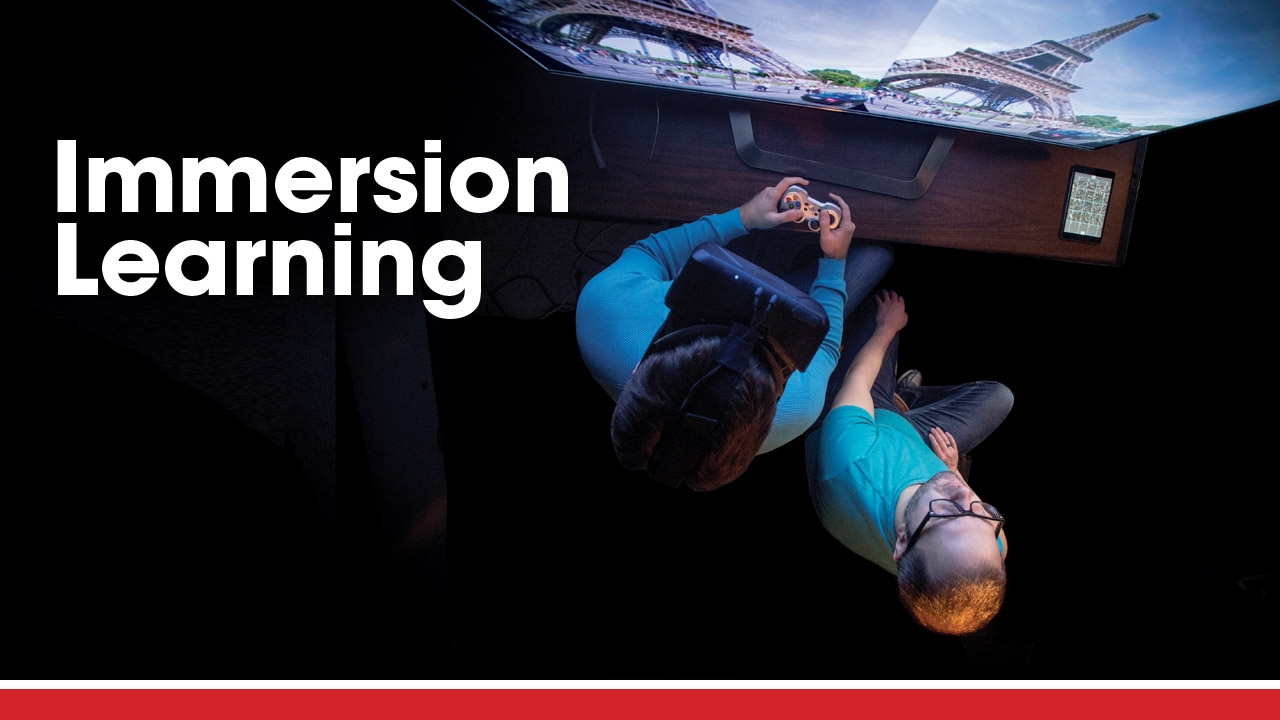 A close-up of a Paris street rendered by the UAB ETLab. Audio programmer Andrew Hyde and media artist Josh Davenport (top of page, left to right) visit the French capital via Oculus Rift.
A close-up of a Paris street rendered by the UAB ETLab. Audio programmer Andrew Hyde and media artist Josh Davenport (top of page, left to right) visit the French capital via Oculus Rift.UAB engineers haven’t invented a teleportation device, but they do have the next best thing. The Enabling Technology Lab (ETLab) within UAB’s Department of Mechanical Engineering can transport you instantly to the busy streets of Paris, to the heart of a war zone, or even deep inside the human body.
You know this technology as virtual reality, which has made its way into nearly every video game. But it’s also a powerful tool for teaching and communication—the focus of the ETLab’s research. “This technology pulls knowledge from a conceptual level into something more tangible,” says Corey Shum, the lab’s technical director. “It provides an experiential understanding of being there.”
So, for example, military pararescue and combat medics can experience the sights, sounds, dangers, and distractions that come with performing their duties in battle. Medical students can see—and walk around—a magnified, three-dimensional model of the human circulatory system. Logistics experts can tour neighborhoods in the French capital before making recommendations for clients based there. The public can even enjoy the thrill of a smooth ride down Birmingham’s Highway 280 on a proposed rapid transit system. Project partners have included the U.S. Department of Defense, the U.S. Department of Energy, the Regional Planning Commission of Greater Birmingham, private industry, and faculty from areas throughout UAB.
“People can read books to understand things,” Shum says. “But we try to train your body and your habits. It’s a full-body teaching experience. People can feel like they’ve been in a space before they actually get there; they know what it’s like to interact with that environment.”
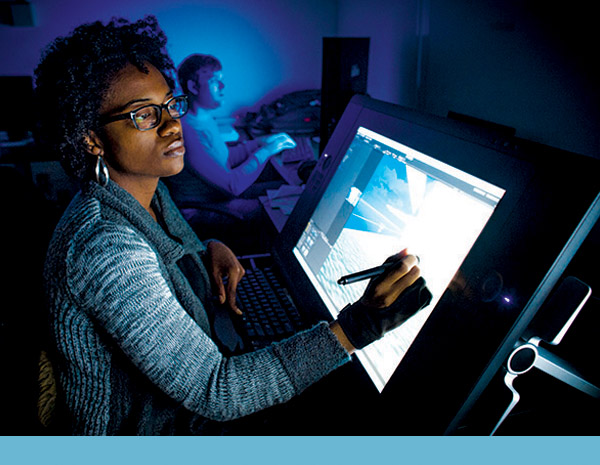 3-D media designer Eva Dennis builds worlds on a touch screen monitor.
3-D media designer Eva Dennis builds worlds on a touch screen monitor.
Art and Engineering
The small, quiet ETLab is a tech-head’s dreamworld, containing equipment such as the Oculus Rift, a headset that contains the latest in virtual-reality technology for game developers. There’s also a computer monitor that’s essentially a giant touchscreen tablet as well as equipment to create and view 3-D images. The next room over contains the VisCube, which can project a 3-D simulation onto three walls and a floor, immersing the viewer in virtual reality. The military first responders train in the VisCube, using a medical mannequin as their patient.
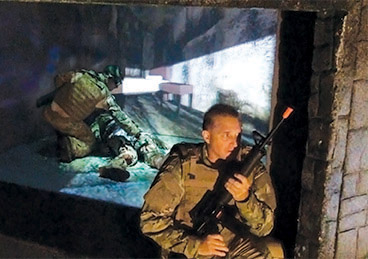 Military first responders train in the ETLab's VisCube, which projects a 3-D simulation onto three walls and a floor, immersing the viewer in virtual reality. They use real-life props and a medical mannequin as their patient.
Military first responders train in the ETLab's VisCube, which projects a 3-D simulation onto three walls and a floor, immersing the viewer in virtual reality. They use real-life props and a medical mannequin as their patient.The people who create new worlds using these digital devices are a mix of engineering researchers, artists, software developers—and even a musician. “Our work is similar to game development, and we use the same tools, but we try to model real things, so it’s more grounded in engineering,” Shum says. “Artists who like to be more technical fit in well; so do engineers who like to be more creative.”
Students also play key roles on the team. The game-development aspect attracted Hannah Hellwig, a junior majoring in computer and information sciences. “I came in as a programmer originally, but I figured out I love 3-D modeling,” says the St. Louis, Missouri, native, who has worked on medical training software, among other projects. “I love learning about game mechanics and how to apply them at a higher level than pure enjoyment and entertainment. The broad brush of things we get to do is unlike any other experience I’ve had.”
Art major Josh Davenport has translated his love for graphic design into 3-D modeling, animation, user-interface design, and videography. He says his art-studio background has come in handy in the lab. “If you understand how to make something with your hands, it’s easier to make it on a computer,” says Davenport, a senior originally from Knoxville, Tennessee. “Knowing how to set up a good composition for a picture helps when I’m doing things like videography, creating a user interface, or arranging lighting in computer models. It all comes together.”
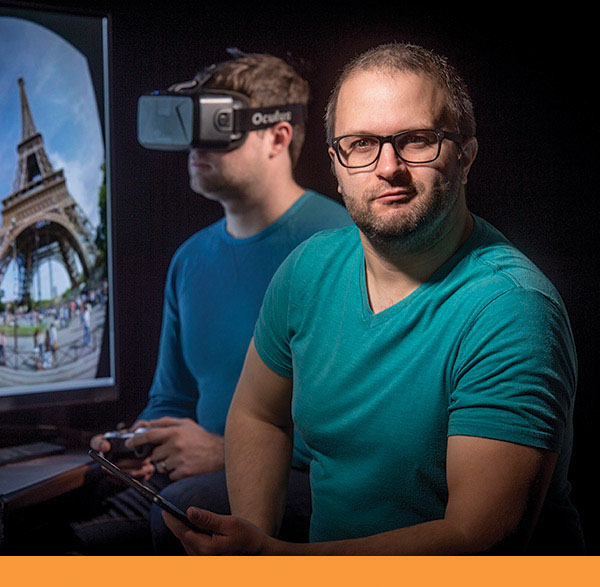 Art major Josh Davenport has translated his love for graphic design into 3-D modeling, animation, user-interface design, and videography. He says his art-studio background has come in handy in the ETLab.
Art major Josh Davenport has translated his love for graphic design into 3-D modeling, animation, user-interface design, and videography. He says his art-studio background has come in handy in the ETLab.Future Views
“It’s easy to imagine, not so far in the future, that technology will disappear a little more, and our realities will converge more,” says Shum, who joined the ETLab as a visualization programmer when it was founded in 2002. “That’s ultimately what everything is driving toward. You’ll be able to communicate with me about your experience, and we’ll be able to share and experience artificial things in that space.”
Take, for example, augmented reality—another focus of the ETLab’s research—which uses devices such as head-mounted displays, tablets, or smartphones to insert digital images or other data into your field of vision. Shum and his team worked with UAB neurosurgeon Barton Guthrie, M.D., to develop “virtual interactive presence” software that enables two people in different places to work together. A remote surgeon, for example, can virtually introduce his or her hands or instruments into the view of a surgeon in an operating room, offering assistance or direction. (UAB has licensed this technology to Vipaar, a company headquartered at Birmingham’s Innovation Depot, which now offers it as the Lime iPhone/iPad app for commercial and personal use. Shum also serves as Vipaar’s technical advisor.)
The future also could look something like a Fitbit, the popular wearable activity tracker, Shum notes. In the ETLab’s virtual reality military training, “we have already put a lot of energy into tracking motion, but also heart rate and galvanic skin response, which is a stress response from your sweat glands, and we would like to know things like blood oximetry and brain activity,” he says. Gathering, studying, and quantifying real-time metrics, which can’t be reported orally, help provide the full picture of an experience—and help the ETLab deliver even more realistic training scenarios. “We mine the data to understand how a person gets an answer or chooses a solution,” Shum adds.
Now Shum and his team are investigating ways to adapt this feedback loop to provide on-the-spot training. “We’re researching wearable technology that will easily capture your entire body’s actions and postures without setting up a complex motion-tracking system,” Shum says.
“In several years,” Shum predicts, “you’ll buy exercise clothes that have built-in sensors that will tell you if your form has gotten out of whack while you’re biking or jogging. You’ll be able to look on your watch—because by then, the phone will be a big relic from the old days—or see in a heads-up display, or just know when you’re doing things right or wrong. There’s no better time to teach somebody than in the moment.”
 No passport required: The ETLab's digital version of a Paris neighborhood enables clients to take a detailed 3-D tour via tablet or laptop.
No passport required: The ETLab's digital version of a Paris neighborhood enables clients to take a detailed 3-D tour via tablet or laptop.
Growing Demand
As technology changes—and shrinks in size—the ETLab plans to grow, Shum says. The $1-billion Campaign for UAB could potentially help the lab expand its reach, bringing its training solutions and expertise to people and companies across the country and around the world. “The technology keeps moving, but what’s important is how we use it as a platform to improve our communication and capacity to understand things,” Shum says. “That’s critical.”
He also seeks more UAB students who want to explore those futuristic frontiers. “There’s a lot of demand for immersive, 3-D training modules at all levels of education and in many career fields, which means there’s a growing need for people who know how to create them.”
“Once you get your hands into the software, you find your niche,” Hellwig adds. “I want to do this type of work as a career.” Davenport, who could take his ETLab experience and pursue jobs at multimedia, animation, or game studios, hopes to join Shum’s team full time after he graduates this year.
Collaborating with artists, rocket scientists, brain surgeons, and everyone from psychologists to business people has been an illuminating experience, Shum says. “Working at UAB affords me a great deal of insight, not only into the things that I find interesting but also into what others find interesting. They open my eyes to their perspective,” he explains.
“It’s fun to connect geniuses together to create something wonderful.”
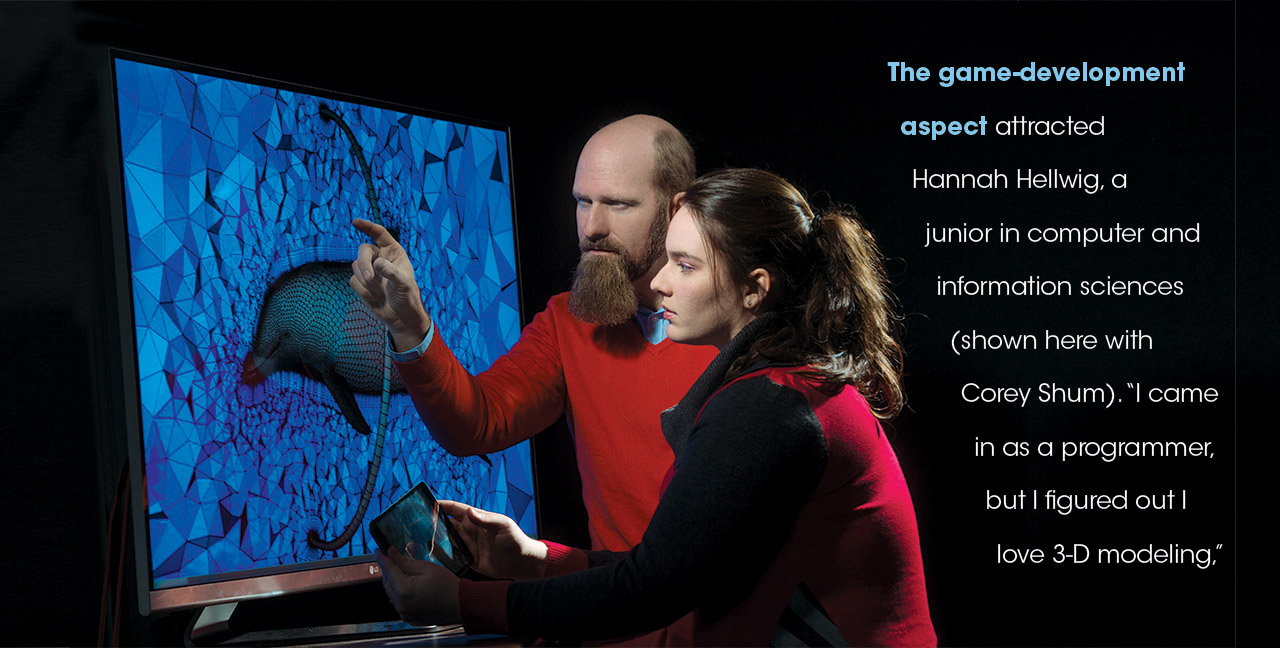
• Explore the ETLab online to learn more about its projects.
• Give something and change everything for UAB's innovative engineering research programs.


